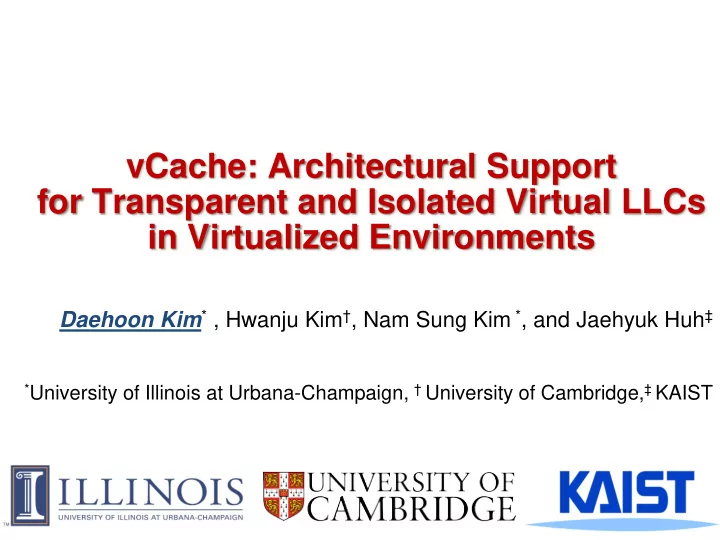

vCache: Architectural Support for Transparent and Isolated Virtual LLCs in Virtualized Environments Daehoon Kim * , Hwanju Kim † , Nam Sung Kim * , and Jaehyuk Huh ‡ * University of Illinois at Urbana-Champaign, † University of Cambridge, ‡ KAIST
2 Virtualized Environments Resource virtualization for VM consolidation Providing an illusion of having dedicated physical resources to a VM e.g., CPU, memory, I/O devices LLC (Last-level Cache) is not virtualized LLC virtualization Transparency : controllable by guest OS o e.g., page coloring Isolation : isolated capacity VM VM VM VM V V V M M M vLLC vLLC vLLC vLLC LLC Providing transparent and isolated virtual LLCs to VMs
3 Background: Page Coloring Page coloring: a software-based LLC placement technique OS controls placement of a page in LLC by manipulating a physical address Balancing cache accesses by spreading data across the entire LLC Partitioning LLC to avoid cache contention page offset page page physical address color color block cache cache offset index Page coloring techniques [MICRO 08’][HPCA 09’][EUROSYS 09’]… Mainstream OS o e.g. Solaris, FreeBSD, WindowNT
4 Background: Memory Virtualization An additional address translation for consolidation Guest-Virtual Address (GVA) to Guest-Physical Address (GPA) by guest OS GPA to Host-Physical Address(HPA) by hypervisor page memory VM 1 allocation memory memory virtualization page memory VM 2 allocation Page coloring of a guest OS becomes ineffective with HPA- indexed LLC
5 Page Coloring in Virtualized Systems Example: pollute buffer mechanism [MICRO 08’] Classify cache unfriendly pages as pollute pages Map pollute pages to an isolated LLC region (pollute buffer) Avoid LLC contentions by pollute pages OS Page coloring (pollute buffer) PA VA LLC pollute pages pollute buffer
6 Page Coloring in Virtualized Systems Example: pollute buffer mechanism [MICRO 08’] Classify cache unfriendly pages as pollute pages Map pollute pages to an isolated LLC region (pollute buffer) Avoid LLC contentions by pollute pages Hypervisor Guest OS Page coloring Memory (pollute buffer) virtualization GVA GPA HPA LLC pollute pages pollute buffer
7 Page Coloring in Virtualized Systems Example: pollute buffer mechanism [MICRO 08’] Classify cache unfriendly pages as pollute pages Map pollute pages to an isolated LLC region (pollute buffer) Avoid LLC contentions by pollute pages # of occurrences of memory ballooning
8 Interference by VM Consolidation Unexpected interference by co-running VMs Page color preservation alone cannot provide benefits of page coloring in consolidated environments OS VM VM Page Page Page Coloring A Coloring B Coloring A Assume that page colors are preserved LLC LLC Non-virtualized System Virtualized System
9 vCache: Transparency GPA-indexed HPA-tagged virtual LLC Use GPA for indexing LLC GVA-to-GPA is managed by guest OS Allow VMs to control LLC placement GPA can be obtained when translating address w/o additional steps GVA By guest OS GPA By hypervisor HPA LLC Maintain Full HPA for tag matching Extend each tag to store HPA color (e.g., 7 bits for 128 colors) Tag Index HPA-indexed LLC Block Offset Tag Tag with HPA Index GPA-indexed LLC Block Offset
10 vCache: Transparency Use HPA for indexing pages that cannot use GPA as LLC index i.e., hypervisor pages and shared pages Extend TLB entry GPA color (e.g., 7 bits for 128 colors) Page status (1 bit) GVA GPA HPA P: normal tag color data P/S Index with GPA S: hypervisor or shared P 0x001 0x05 0x010 Index with HPA S 0x003 0x06 0x020 LLC TLB Cache coherence support Coherence requests maintain GPA color bits Extend L1/L2 cache tags to store GPA color for write-back to LLC
11 vCache: Isolation Isolated capacity: VM-based LLC partitioning in way granularity vLLC partition table o Maintain vLLC capacity mandated by the contract with its user o Set by hypervisor Work-conserving policy: Unreserved/unused capacity is shared Modified LRU: Choose a cache line belongs to VMs with more cache lines than allocated capacity as a victim VM-1 and VM-3 have more cache lines than allocated capacity MRU Counter VMID Capacity 3 VM-1 2 way(s) VM-2 4 way(s) 3 VM-3 3 way(s) 4 VM-4 3 way(s) 2 LRU vLLC partition table vCache chooses a cache line closer to global LRU position
12 Experimental Methodology Running Xen hypervisor on SIMICS Pollute buffer mechanism [MICRO 08’] and ULCC [PPoPP 11’] o ULCC: User-level page coloring interface 1 way = 1 MB: 4MB, 8MB, and 12MB LLC Workloads o Mixes of SPECCPU benchmarks for pollute buffer o Pluto benchmarks for ULCC Change GPA-to-HPA mappings with memory ballooning VM VM pollute ULCC buffer Xen hypervisor full-system simulator
13 Results with Single VM IPC improvement – after initial booting HPA-indexed LLC shows almost same results with vCache after initial booting
14 Results with Single VM IPC improvement – after ballooning For hmmer, vCache shows 17% IPC improvement while HPA-indexed LLC shows less than 1% improvement after memory ballooning
15 Results with Multiple VMs IPC improvement: two VMs (VM1: 4MB, VM2: 8MB) Each of which runs with pollute buffer and ULCC with GPA- based indexing GPA-based indexing alone cannot preserve effectiveness of page coloring in consolidated environment
16 Results with Multiple VMs IPC improvement: two VMs (VM1: 4MB, VM2: 8MB) Each of which runs with pollute buffer and ULCC with GPA- based indexing For soplex, sLLC further improves performance by 37% points while it degrades performance of co- running VM by 23% points
17 Results with Multiple VMs IPC improvement: two VMs (VM1: 4MB, VM2: 8MB) Each of which runs with pollute buffer and ULCC with GPA- based indexing vCache preserves the effectiveness of page coloring by guest OS with isolated capacity
18 Conclusion vCache provides a transparent and isolated virtual LLC to a VM Transparency: GPA-indexed HPA-tagged Isolation: VM-based LLC partitioning in way granularity vCache preserves the page coloring policy deployed by each VM as non-virtualized systems VM VM VM VM Page Page Page Page coloring A coloring B coloring C coloring D vLLC vLLC vLLC vLLC LLC
Recommend
More recommend